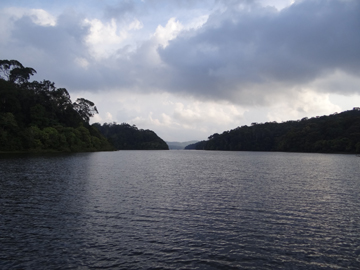Periyar Tiger Reserve, Kerala
-Text and Photographs
Dr.Susan Sharma, Founder, IndianWildlifeClub.com
My first trips to the Periyar Tiger Reserve (PTR), known as Thekkady to many, were as a young adult way back in the 70's and 80's. A lasting memory from those visits is watching herds of elephants crossing the Periyar River, the matriarchs helping along
baby elephants. Beyond the memory of a holiday well spent watching wildlife, the visits were not really transformative. The transformation happened much later when I started visiting the Corbett National Park. What was it in Corbett that made me fall in
love with the forests?
During the earlier visits to Periyar Tiger Reserve, I had always taken a boat trip. Travel in a boat in the Periyar Lake and observe wildlife in the forest -mainly elephants, bison, and birds. The visits to Corbett on the other hand have mostly been
on elephant backs, the captive elephant making its own path in the forest while four or five tourists sit on its back on the howdah. In the sixties and seventies there were hardly any wildlife resorts outside the Park, so one invariably got to stay in the
forest rest houses or Dhikala. Regulations about trekking were limited, which meant we could go on treks in some areas. In short, in Corbett, one experienced the forest on foot or on elephant back (one can look up at the canopy and touch the leaves) which
made you develop a bond with the forest and its animals and you got hooked to it for life.
I had heard that Periyar Tiger Reserve had also started allowing tourists to go on treks. T.K Sajeev, who I had known when he was in Conservation Education Centre of Bombay Natural History Society, was now the Nature Education Officer at PTR. Added incentive
to visit PTR! So this time, in addition to the customary boat trip we planned a trek into the Forest. This is the story of that trek- how even a three hour walk can make you feel one with nature.
While planning the trip from Kochi, which is about 190 km by road, we also made plans to visit Gavi (14km from PTR ) so that our experience of the Southern Western Ghats is complete. Gavi is part of PTR and can be covered in a day and night trip. The
experience of trekking in Gavi is a good introduction to what awaits you at PTR.
Gavi
The trek takes you over vantage points to see the hills of Sabarimala which is a pilgrimage centre located at PTR.
A monsoon trek in Gavi is recommended for anyone who is not afraid of leeches. Despite precautions, leeches are bound to suck some of your blood, especially if you are a first time trekker. You learn to avoid them using protective gear, sprinkling salt
to deter them, failing which learn to deal with them.
At any rate, leeches were not going to stop us from experiencing PTR first hand under the expert guidance of Sajeev! So, there we were in PTR in September 2014, four of us co-travellers, in many a nature trip around the country.
Periyar Tiger Reserve
PTR with an area of 925Km is the oldest and largest protected area (PA) in Kerala. Originally constituted as a Game Sanctuary, viz., Nellikampetty Game Sanctuary in 1934, PTR evolved as Periyar Wildlife Sanctuary in 1950 and Periyar Tiger Reserve in 1978.
Through the implementation of India Eco development project from 1996 to 2004, PTR has emerged as a national role model for participatory conservation. PTR was awarded UNDP award for best managed protected area in 2012. In 2015, PTR bagged the National
Tiger Conservation Authority (NTCA) biennial award for encouraging local public participation in managing the Reserve.
Rivers originating from the forested tracts of PTR, namely, Periyar, Pamba and Azhuta form the lifeline for millions of people of Kerala and Tamil Nadu. The unique man made Periyar lake (26km) is an important water source for Tamil Nadu for irrigation,
drinking and power generation.

Periyar lake
Sighting of wild animals at close quarters from boat is a memorable experience for tourists. The customary boat trip for any visitor to PTR was on our agenda on day 1. We found groups of Asian elephants grazing in the lush forest completely oblivious
to the boats criss-crossing the lake; Barking deer groups and gaurs could also be spotted. The expanses of the Periyar lake separating the humans from animals made the water birds and other animals who came to the lake completely at peace. There was no
rushing out and running around witnessed, as seen when jeeps and cantors in many Reserves approach animals.
Elephants-View from the boat
Day 2 saw us getting ready for the much anticipated trek. PTR has a cool and humid climate with comparatively high rainfall. April-May are the hottest and December-January the coolest. Rainy season had just got over and the climate was pleasant.
Sajeev advised that we spray a good amount of Dettol on our sox and pants to dissuade leeches. And that came out to be an excellent tip. Rajkumar, our guide started explaining the forest types in PTR. Seven types of vegetation have been identified from
Periyar Tiger Reserve, of which evergreen and semi evergreen forests form the major portion. Besides these marshy grasslands and montane grassland sholas form extremely valuable micro ecosystems.
A bamboo raft carried us to the dense forest.
.jpg)
All set for the trek
(To be continued)